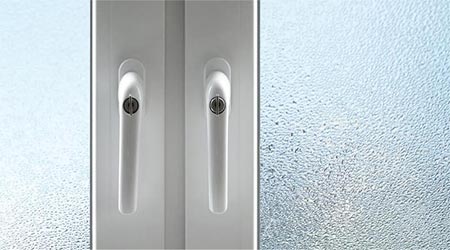Millions of homes in the UK experience some form of condensation every year. So if it’s something that you’ve spotted in your property, you’re not alone. The simplest signs that you’ve got condensation are where you can see water droplets streaming down the insides of your windows, particularly in the mornings. You might have even spotted it on your walls too. It’s more likely to affect single-glazed windows than double-glazed, however, it’s not impossible to see condensation there too.
You might be surprised to hear that it happens more frequently when the weather is colder. Condensation tends to happen where humidity rises, and as air can only hold a certain amount of moisture, if the air becomes cooler by contact with a cold surface like a window or wall, it can be seen as the droplets that you will have recognised.

It’s very simple for this to happen. Even breathing can cause condensation. Simple daily activities like showering, cooking and drying laundry indoors can create water vapour into the air which can soon cause a problem. If the moisture doesn’t have a chance to escape you may start to see signs of condensation. So if you’ve seen symptoms like damp walls and blistering of wallpaper or a musty or damp smell, it’s highly probable that condensation has started to affect your property. You may have noticed areas of mould growing, perhaps in the corners of your walls or ceiling. It may have been spotted in your wardrobe – in your shoes or even on bedding where your bed is next to an outside wall.
Managing Condensation
There are quite a few things that you can do to prevent condensation from happening in the first place. If you’re cooking, make sure you use an extractor fan and keep any boiling pans covered with a lid. Make sure your bathroom is ventilated wherever possible, and keep your door closed when showering or bathing. If you’re drying clothes, avoid drying them indoors, if this cannot be avoided then ensure the property is sufficiently ventilated. It’s important that you keep your heating on a low level so that there isn’t a rapid temperature change so that your walls don’t have a chance to get cold.

If you’ve got cavity insulation at your property you may think that this will solve your problem. However, like double-glazing, this can actually exacerbate the problem. The key to getting rid of condensation in your home is making sure that you have proper ventilation so that the condensation doesn’t get a chance to form in the first place. It’s vital to find the right balance between damp proofing and proper ventilation. And that’s where the Schrijver system can certainly help.
Delivering an eco-friendly, cost-effective solution that’s entirely chemical-free, installing the Schrijver system means that your property will have a solution that does not create any mess and there’s no redecoration needed. Not only that, it’s kinder to the environment and safe for all of the family. Handmade elements are installed into your walls which means that dry air is able to flow through from the outside and humid air is able to escape. This means that you’ll now have dry walls and continuous protection against any condensation or damp issues.






